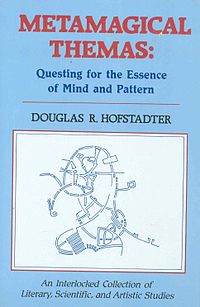This article includes a list of general references, but it lacks sufficient corresponding inline citations .(February 2013) |
 Cover of the first edition | |
| Author | Douglas Hofstadter |
|---|---|
| Language | English |
| Subjects | Frederic Chopin, free will, Heisenberg principle, innumeracy, Lisp, memes, prisoner's dilemma, quantum mechanics, Rubik's Cube, William Safire, strange attractors, Alan Turing, etc. |
| Published | 1985 |
| Publisher | Basic Books |
| Publication place | United States |
| Media type | |
| Pages | 852 |
| ISBN | 0-465-04566-9 |
| OCLC | 11475807 |
Metamagical Themas is an eclectic collection of articles that Douglas Hofstadter wrote for the popular science magazine Scientific American during the early 1980s. The anthology was published in 1985 by Basic Books.
Contents
- Contents
- List of Hofstadter's "Metamagical Themas" columns
- French edition
- Reception
- References
- External links
The volume is substantial in size and contains extensive notes concerning responses to the articles and other information relevant to their content. (One of the notes—page 65—suggested memetics for the study of memes.)
